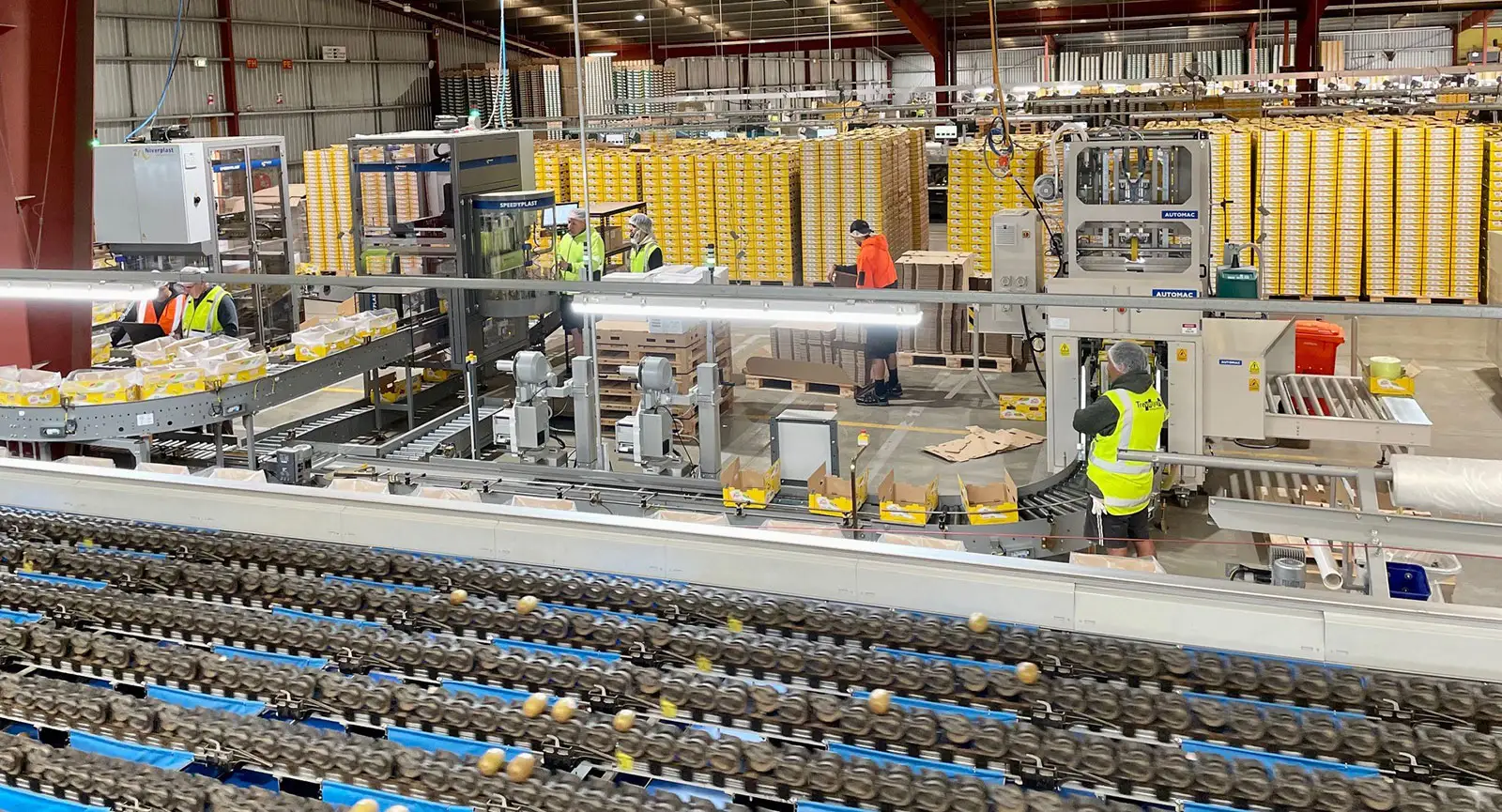Horticulture business Trevelyan’s is focused on improving energy efficiency across the business, including cutting electricity use, streamlining processes, and managing peak demand more effectively.
Head of Sustainability, Sarah Lei, says there’s a lot to consider and stakeholders involved.
“But at the end of the day, we’re all aiming for the same thing — reliable, affordable energy that works for the long haul.”
About Trevelyan's
Based in Te Puke, Trevelyan’s provides postharvest services for the kiwifruit and avocado industries. This includes orchard management, picking, packing, cool storage, and technical support.
The company’s thirty-hectare site includes 43 coolstores, one domestic market packhouse, and four export packhouses.
Refrigeration is the largest energy cost for Trevelyan’s, with coolstores making up 85% of site’s energy consumption, so improving coolstore energy efficiency is vital.
Whilst the coolstores have integrated refrigeration systems, Trevelyans’ packhouses are also equipped with HVAC systems which ensures the fruit stays cool to help the labels stick.
In 2022, refrigeration systems accounted for 16,040TJ of New Zealand’s electricity use — the fourth highest electricity demand after hot water cylinders, electric furnaces and motors.
One of the biggest opportunities for businesses to reduce costs is to optimise refrigeration systems and develop a smart energy management system alongside employing demand flexibility to support grid resilience.
Future-proofing
Trevelyan’s initially focussed on refrigerants and refrigerant leaks which were a significant component of the organisation’s emission profile.
“We have quite a lot of old refrigeration equipment and with carbon prices going up — leaks became a lot more expensive. We reduced our refrigerant leaks which had a big impact,” said Lei. Seeing the positive effects of that work, spurred the team to look at what else they could do.
Lei says the organisation has evolved alongside changes in the market and the availability of new tools and data.
“We have lots of coolstores on our site, so energy is a big financial cost. It is important for us to have a strategy.”

Integrating demand flexibility
Trevelyan’s energy use peaks in autumn, with electricity being a major component.
“With only annual data, it’s hard to pinpoint where energy use is highest and how to reduce it,” says Lei.
One area they could influence was the timing of electricity use.
Trevelyan’s energy supplier offers a fixed price variable volume agreement — which provides long-term visibility of electricity prices.
A dashboard enables the team to see how the grid supply has been operating and how that translates into the energy the business is using. This helps make better decisions around energy use. The carbon dashboard also compares actual monthly emissions factors with the most recent MfE data.
Turning insight into impact
Trevelyan’s saw an opportunity to introduce demand flexibility through load shedding. Electricity is more expensive in the winter and in the early morning and evening (when demand is high) so turning off coolstores at these times saves. Grid emissions factors are also typically high at these times so reducing demand can also lead to reductions here.
“It’s about the demand flexibilities. We can make decisions for a half hour period which will ultimately make a difference. We monitor the coolstore temperatures closely to ensure there is no impact on fruit quality.
Trevelyan’s has also partnered with its energy provider to put more monitoring into their cool stores. This means when the grid is under pressure or there is high energy demand, a signal will be sent to Trevelyan’s asking the organisation to turn equipment off for a short period of time.

The benefits of using demand flexibility
“In 2024 there was a crazy amount of fluctuation in energy supplies. Demand flexibility gives us some control and helps make a difference,” said Lei.
“It's been hard for us to achieve our emissions reduction targets, but this is a pretty good success story. We managed to hit our target for 2024, but 2025 will be even harder.”
The team have adopted other energy efficient projects including installing LED lights throughout the pack house which has made a difference to both energy savings and emissions data.
“While is it is only 2% (energy savings) and it's hard to see in the scheme of things — that 2% was probably the bit that we needed to reach our target.
“Our goals are to work smart, tread lightly, and respect our people. Respecting our people by giving them better lighting, also helps them work smart as well, because they can see defects the fruit better.”
While Trevelyan’s has had some success with demand flexibility, it hasn’t been without its challenges.
“What we're talking about here is quite complicated so how do you take everyone on that journey? There's definitely the challenge of getting everyone on the board to understand what we're trying to do and how we're going to achieve it.
“The other thing is funding. There's always the challenge of putting in meters, putting in lights, and while there definitely are a lot of savings, at the beginning it's hard to measure the payback."
Our goals are to work smart, tread lightly, and respect our people. Respecting our people by giving them better lighting, also helps them work smart as well, because they can see defects in the fruit better.
How demand flexibility works
About 80-85% of New Zealand’s electricity comes from renewable sources, but some, like solar and wind, are intermittent. At peak times — mornings, evenings, and in winter — fossil fuels fill the gap. Reducing electricity use during these periods is valuable as demand grows.
The ability for businesses to switch fuels, adjust production rates and optimise energy demands can make a huge difference to the resilience and profitability of an energy-intensive commercial or industrial operation, while contributing to the stability of the electricity grid.
Like Trevelyan's, businesses can also optimise energy use within their facilities by deploying smart energy management systems that adjust lighting, HVAC, and other equipment settings based on occupancy, weather conditions, and energy prices.
Businesses can also voluntarily shift their electricity demand to off-peak hours through lower-priced electricity rates and plans, or in response to an alert from suppliers.
Future projects: more energy efficiency, possibly solar
With the lighting and energy plan underway, Trevelyan’s is looking towards other efficiency projects. Alongside coolstore monitoring, Lei says they are looking at the individual efficiency of each store, as well the age of each one, what refrigerant they run on and whether they are fitted with a rapid door.
“Using this data, we can see whether some coolstores are running more efficiently than others and try to understand why.”
Trevelyan’s is also working on an energy strategy study which is looking at the feasibility of solar on the site given their load profile is inversely proportional to any solar generation.
“We use more energy in winter, so we will need more solar panels, then will end up with excess energy in the summer months.
“We are working with a number of stakeholders and people within the bigger ecosystem who might be able to help us do things. I'm really excited about it, but I don't have any preconceptions about where it might go, because it's just about us learning more and figuring out more,” says Lei.
“We are working with our people to give them the right tools — everything is solvable through curiosity, through learning.”
“We have to keep coming up with new ideas. It's definitely part of our DNA, but it's not always easy.”
Advice for businesses
- Start small — You’ve got to start somewhere, so start small, pick off the low hanging fruit, and generally efficiency work will be the stuff with the least cost.
- Be curious — Don't be scared to ask dumb questions and learn from everyone else along the way. Understanding all the information is such a learning journey. It's great having consultants to come and help you, but ultimately, you'll need to understand your own systems better.
- Measure everything — Collect your data so you've got baselines to work with. You can’t do anything meaningful without data. Collect as much data as you can on everything.
Energy efficiency for packhouses and coolstores
EECA’s packhouse and coolstore pathway provides free tailored tools and resources for businesses to help the sector save money and be more energy efficient.
Image courtesy of Pavel Kostenko.
Read next
-
Demand flexibility — a smarter grid
Learn about how effective demand management supports a more efficient and affordable electricity system.
- Electricity
- Renewable energy
- Smart technology
-
Energy flexibility for industrial businesses
As energy costs fluctuate and grids evolve, energy flexibility is becoming a crucial advantage for industrial operations.
- Electricity
- Innovation
- Fuel switching
-
Commercial-scale solar in New Zealand
Information for businesses considering investing in solar energy.
- Renewable energy
- Solar energy
- Decarbonisation


